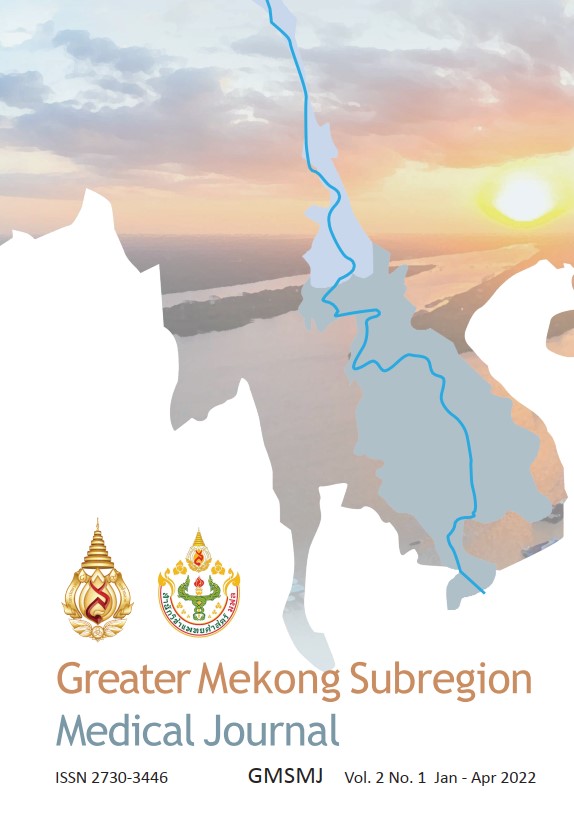Okra Jelly Affecting Self-Perceived Xerostomia and Oral Health Related Quality of Life in The Elderly: A Preliminary Study
Keywords:
Elderly, Okra, Quality of life, XerostomiaAbstract
Background: The prevalence of xerostomia, the subjective sensation of dry mouth, is quite high in elder people. Okra contains mucilaginous substance which has moisturizing and lubricating properties similar to human natural saliva.
Objective: This study aimed to investigate if okra jelly can affect self-perceived xerostomia and oral health related quality of life in the elderly.
Methods: We used an experimental study. There were 12 participants. We allocated 2 groups: the experimental group used okra jelly and the control group used jelly without okra. Participants received jelly twice daily, between breakfast-lunch and lunch-dinner for 24 days. Self-reported visual analogue scale (VAS) for dry mouth and the Thai version of Oral Health Impact Profile-14 (OHIP-14-Th) had been done at before intervention, Day 12, and Day 24. Two-sample Wilcoxon rank-sum (Mann-Whitney) test, multilevel mixed-effects logistic regression and GEE population-averaged model were used for analyzing the differences between tests and controls at different studied times with p-value < 0.05 was considered to be significant.
Results: After adjusting baseline VAS and OHIP-14-Th score, age and gender, the results showed that every 12-day, the VAS score of the experimental group decreased significantly (p < 0.01) and the control group decreased insignificantly. Comparing the two groups, it was found that the experimental group had a greater score reduction significantly (p< 0.01). The results of OHIP-14-Th score every 12-day showed that both the experimental and control groups decreased significantly (p < 0.01). Comparing the two groups, it was found that the experimental group had a greater score reduction, however, insignificantly.
Conclusion: Okra jelly seems to have promising results on the reduction of self-perceived xerostomia and oral health related quality of life in the elderly.
References
Razak PA, Richard KM, Thankachan RP, et, al. Geriatric oral health: A review article. J Int Oral Health. 2014; 6 (6): 110-6.
Narhi TO. Prevalence of subjective feelings of dry mouth in the elderly. J Dent Res. 1994; 73 (1): 20–5. https://doi.org/10.1177/00220345940730010301.
Bing Liu, Dion MR, Jurasic MM, et, al. Xerostomia and salivary hypofunction in vulnerable elders: prevalence and etiology. Oral Surg Oral Med Oral Pathol Oral Radiol. 2012; 114: 52-60.
Paredes-Rodríguez VM, TorrijosGómez G, González-Serrano J, et, al. Quality of life and oral health in elderly. J Clin Exp Dent. 2016; 8 (5): e590-6. https://doi.org/10.4317/jced.53317
Ikebe K, Matsuda K, Morii K, et, al. Impact of dry mouth and hyposalivation on oral health related quality of life of elderly Japanese. Oral Surg Oral Med Oral Pathol Oral Radiol Endod. 2007; 103 (2): 216-22. https://doi.org/10.1016/j.tripleo.2005.12.001.
Niklander S, Veas L, Barrera C, et, al. Risk factors, hyposalivation and impact of xerostomia on oral health-related quality of life. Braz Oral Res. 2017; 31: e14.
Molania T, Alimohammadi M, Akha O, et, al. The effect of xerostomia and hyposalivation on the quality of life of patients with type II diabetes mellitus. Electronic Physician. 2017; 9 (11): 5814-19. https://doi.org/10.19082/5814
Plemons JM, Al-Hashimi I, Marek CL, American Dental Association Council on Scientific A. Managing xerostomia and salivary gland hypofunction: Executive summary of a report from the American Dental Association Council on Scientific Affairs. J Am Dent Assoc. 2014; 145 (8): 867-73.
Dost F, Farah CS. Stimulating the discussion on saliva substitutes: a clinical perspective. Aust Dent J. 2013; 58: 11–7. https://doi.org/10.1111/adj.12023
Villa A, Connell CL, Abati S. Diagnosis and management of xerostomia and hyposalivation. Ther Clin Risk Manag. 2015; 11: 45–51. https://doi.org/10.2147/TCRM.S76282
Salum FG, Medella-Junior FAC, Figueiredo MAZ, et, al. Salivary hypofunction: An update on therapeutic strategies. Gerodontology. 2018; 35 (4): 305-16. https://doi.org/10.1111/ger.12353
Kumar DS, Eswar DT, Kumar AP, et, al. A review on: Abelmoschus esculentus (okra). Int Res J Pharm App Sci. 2013; 3 (4): 129-32.
Gemede HF, Ratta N, Haki GD, et, al. Nutritional Quality and Health Benefits of Okra (Abelmoschus esculentus): A Review. J Food Process Technol. 2015; 6: 458. https://doi.org/10.4172/2157-7110. 1000458
Elkhalifa AEO, Alshammari E, Adnan M, et, al. Okra (Abelmoschus Esculentus) as a Potential Dietary Medicine with Nutraceutical Importance for Sustainable Health Applications. Molecules. 2021; 26 (3): 696. https://doi.org/10.3390/molecules26030696
Manosroi A, Pattamapun K, Khositsuntiwong N, et, al. Physicochemical properties and biological activities of Thai plant mucilages for artificial saliva preparation. Pharm Biol. 2015;53 (11): 1653-60. https://doi.org/10.3109/13880209.2014.1001402
Manosroi A, PattamapunK, Chankhampan C, et, al. A biological active artificial saliva formulation containing flower mucilage from Ceylon Spinach (Basella alba Linn.). Saudi J Biol Sci. 2020; 27: 769-76.
Baker SR, Pankhurst CL, Robinson PG. Utility of two oral health-related quality-of-life measures in patients with xerostomia. Community Dent Oral Epidemiol. 2006; 34 (5): 351-62. https://doi.org/10.1111/j.1600-0528.2006.00285.x.
Botelho J, Machado V, Proença L, et, al. Perceived xerostomia, stress and periodontal status impact on elderly oral health-related quality of life: findings from a cross-sectional survey. BMC Oral Health. 2020; 20: 199 https://doi.org/10.1186/s12903-020-01183-7
Chatalongkorn S. Psychometric Properties of Thai Version of the Oral Health Impact Profile (OHIP-14 Thai). J Prapokklao Hosp Clin Med Educ Center. 2017; 34 (3): 158-70.
Nammontri O. Validation of the Thai version of the 14-item oral health impact profile (Thai OHIP-14) amongst the general Thai adult population in a community setting. J Health Res. 2017; 31 (6): 481-6. https://doi.org/10.14456/jhr. 2017.59
Regelink G, Vissink A, Reintsema H, et, al. Efficacy of a synthetic polymer saliva substitute in reducing oral complaints of patients suffering from irradiation-induced xerostomia. Quintessence Int. 1998; 29: 383-8.
Polland KE, Higgins F, Orchardson R. Salivary flow rate and pH during prolonged gum chewing in humans. J Oral Rehab. 2003; 30: 861–5.






